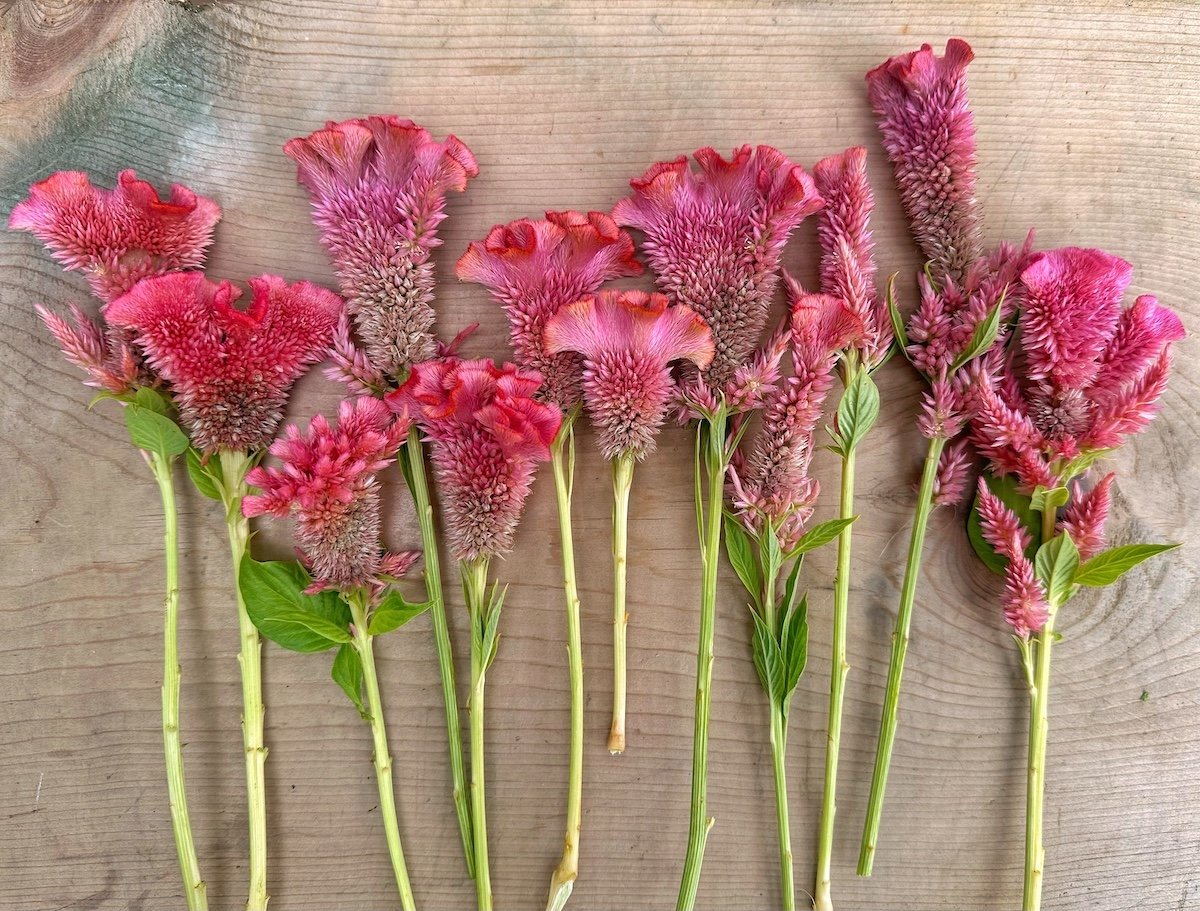Cultivating Specialty Celosia at PepperHarrrow
At the heart of our flourishing flower farm, live two self professed plant nerds, Adam and Jenn. Haha! Yes, that’s us. We’ve been doing something special on our flower farm over the last eight years to elevate the beauty of celosia blooms.
It started with a small patch of heirloom peach celosia blooms that started to cross with one of our hot pink varieties, creating a gorgeous peach/hot pink variegation, which was pretty cool to see. From there, we started to see our original peach variety morph into a gorgeous coppery color. Finally, we saw one of our pink varieties of plumed celosia start to take on a blush color with hints of coral. We knew we had found another favorite that we wanted to separate out to create a gorgeous new variety.
After seeing each of these unique varieties, we started on a three year journey to begin to separate genetics on each of these gorgeous abnormalities to create three stunning varieties we now have named: Chester Copperpot, Starlight, and Rainbow Sherbet.
In this blog post, we will talk a little more about these varieities and dip our toes into the interesting world of genetic experimentation and take a glimpse at the process behind the creation of our unique celosia varieties.
Separating Genetics
Creating new and distinct celosia varieties involves separation of genetics to isolate desirable traits (form, color, etc). As we discussed above with our celosia experimentation, we focused on traits like unique color traits, and unique shapes.
The process can be summarized in a few key steps:
Selection of Parent Plants: We began by selecting parent plants with the desired traits we wanted to see in our new celosia varieties. Chester Copperpot, Starlight, and Rainbow Sherbet were envisioned to be extraordinary in color, form, and overall aesthetic appeal.
Cross-Pollination: Natural pollinator (bee, butterfly, beneficial insect) cross-pollination was carried out between the selected parent plants. This involved transferring pollen from the male flowers of one plant to the female flowers of another. This mixing of genetic material set the stage for the creation of unique combinations. It’s worth mentioning that if you want to be more intentional with your crosses, you should do this process by hand and isolate the plants, covering as to not allow further open cross-pollination.
Isolation of Traits: After successful cross-pollination, the seeds obtained carried a diverse genetic makeup. The next step was to take note of all of the plant details, color, size, etc, and isolate the specific traits we aimed to emphasize. This process required quite a bit of patience and attention to detail.
Generation Selection: Over successive generations, we kept selecting plants that exhibited the desired traits consistently. This process helped refine the genetic makeup, ensuring the stability of the characteristics we sought in our celosia varieties.
The birth of Chester Copperpot, Starlight, and Rainbow Sherbet. After years of dedicated work and nurturing, the distinctive celosia varieties—Chester Copperpot, Starlight, and Rainbow Sherbet—blossomed into existence. We love getting to share these unique varieties with gardeners, flower growers, and flower farmers alike!
Chester Copperpot Mix
With its rich coppery hues and fun shape, Chester Copperpot is a stand out of our variety. This mix comes in coppery shades shown here, as well as gold, hot pink, and red.
Starlight Mix
True to its name, Starlight boasts blooms that look like starlight. The delicate interplay of colors and the unique flower structure make Starlight a celestial beauty that captivates all who behold it.
Rainbow Sherbet
A burst of variegated, vibrant colors characterizes Rainbow Sherbet. With hues reminiscent of a summer sunset, this variety is a harmonious blend of fuchsia and orange. Each bloom is a sweet treat for the eyes.
Our journey doesn’t end here. With these absolutely gorgeous varieties we’ve grown, we’re even more intrigued and excited to create even more beautiful varieties. Over the growing season, we snagged a few more unique specimens that we have high hopes for in the future. Shown below is our latest celosia that we’ve already pre-named ‘Pink Lemonade’. If we can isolate them and get them to keep this unique color over the next two growing seasons, this will be one we will release into the growing market.
PepperHarrow's venture into genetic experimentation has had great success. Three new, extraordinary celosia varieties have been created out of this process to grace gardens all over the country.
Chester Copperpot, Starlight, and Rainbow Sherbet are not just flowers; they are living works of art that showcase the endless possibilities within the realm of horticulture. As we continue to push the boundaries of floral beauty, our flower farm remains a testament to the intersection of science and nature, where innovation blooms in every petal.
XX Jenn and Adam






